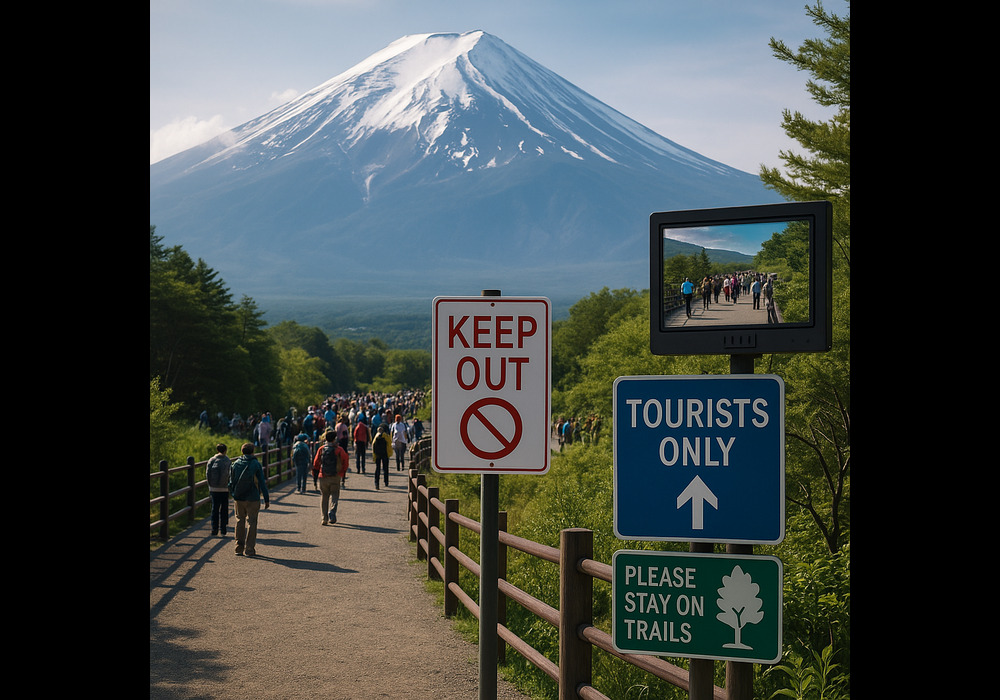Discover how Japan’s crowd control strategies at Mount Fuji offer vital lessons in managing overtourism at iconic travel sites worldwide.
Introduction: The Price of Popularity
Imagine standing atop Japan’s sacred Mount Fuji at sunrise—golden hues splashing across a sea of clouds. It’s magical, spiritual, and… packed with hundreds of tourists jostling for space. In recent years, what should be a serene, once-in-a-lifetime experience has increasingly felt like a crowded theme park. This rising pressure on iconic destinations is a global issue, but Japan’s crowd control: lessons from Mount Fuji in managing overtourism at iconic sites is quickly becoming a model for sustainable tourism.
Mount Fuji, a UNESCO World Heritage Site and cultural symbol of Japan, now receives more than 220,000 climbers each season. With this surge in tourism comes litter, safety concerns, and environmental degradation. In response, Japan has taken decisive action that many countries should take note of.
Mount Fuji’s Overtourism Problem
From Spiritual Ascent to Tourist Jam
Traditionally, Mount Fuji was a pilgrimage site—climbed for spiritual reflection, not selfies. But the combination of social media fame, improved access, and international travel booms has transformed the mountain into a bucket-list hotspot.
Key challenges Mount Fuji has faced:
- Overcrowded trails, especially during climbing season (July–September)
- Increased litter and waste disposal issues
- Environmental erosion on sacred and fragile terrain
- Health & safety hazards from unprepared climbers
Japan’s efforts to preserve the mountain began with awareness campaigns and voluntary donations but ramped up drastically in 2024 and 2025.
New Measures Introduced at Mount Fuji
1. Daily Climber Limits
As of 2024, Japan has imposed a daily cap of 4,000 climbers on the popular Yoshida Trail. This has dramatically reduced peak crowding, especially during sunrise ascents.
2. Mandatory Fee and Advance Booking
Visitors are now required to pay a 2,000 yen (approx. $13 USD) entry fee and book in advance through an online system. This not only regulates numbers but also ensures climbers receive safety guidelines and preparedness information.
3. Trail Closures and Rest Periods
Parts of Mount Fuji are now periodically closed to allow the ecosystem to recover. These “rest periods” are essential to long-term sustainability.
4. Staffing and Surveillance
Japan increased onsite staff, including multilingual guides, medical teams, and cleanup crews. Surveillance cameras now monitor high-traffic areas to ensure rules are followed.
Learn more about Japan’s official climbing measures
How Mount Fuji Compares Globally
| Iconic Site | Overtourism Issue | Crowd Control Strategy |
|---|---|---|
| Mount Fuji, Japan | Trail erosion, overcrowding | Climber cap, entry fee, bookings |
| Machu Picchu, Peru | Structural damage, litter | Limited permits, time slots |
| Venice, Italy | Infrastructure strain | Visitor tax, cruise ship bans |
| Yosemite, USA | Traffic jams, habitat damage | Vehicle reservations, shuttle buses |
| Borobudur, Indonesia | Monument wear | Entry quotas, off-limit areas |
These comparisons highlight how Japan’s system is flexible, digital-first, and culturally sensitive.
Key Insights from Japan’s Approach
1. Proactive Planning Beats Reactive Panic
Rather than waiting for irreversible damage, Japan anticipated tourism pressures and designed scalable systems. This long-term vision helped reduce backlash from travelers and businesses alike.
2. Technology Enhances Regulation
Using online booking systems, mobile alerts, and surveillance tech, Japan made enforcement seamless while offering convenience to tourists. These systems also collect data for future policy adjustments.
3. Education is Half the Battle
Japan’s tourism board placed a strong emphasis on climber education. Informational videos, multilingual guides, and clear signage made sure visitors understood not only the rules but why they exist.
4. Community Involvement is Crucial
Local businesses, volunteers, and municipalities around Mount Fuji were involved in planning. This grassroots collaboration ensured smoother implementation and stronger local support.
5. Cultural Respect is Central
Japanese authorities respected Shinto beliefs tied to Mount Fuji while implementing regulations, maintaining the mountain’s sacred aura despite logistical changes.
What Can the World Learn?
Destination Managers:
- Implement caps on daily visitors
- Use dynamic pricing or fees to control peak flows
- Leverage smart tech for monitoring and bookings
Tourists:
- Plan ahead and respect rules
- Support destinations through responsible travel fees
- Avoid peak season when possible
Governments:
- Work with local communities and conservationists
- Invest in eco-friendly infrastructure
- Adopt education-first policies rather than harsh penalties
Visual Summary: Mount Fuji Overtourism Strategy
| Strategy | Impact |
| Daily climber cap | Reduced trail congestion |
| Entry fee + booking | Improved preparedness and revenue |
| Trail closures | Ecosystem recovery |
| Staff & surveillance | Enhanced safety and compliance |
| Public awareness | More respectful tourist behavior |
Conclusion: The Path Forward
Japan’s response to Mount Fuji’s overtourism isn’t perfect, but it’s among the most comprehensive and culturally aware strategies we’ve seen to date. As global tourism continues to rebound, these lessons are more urgent than ever.
The blend of tradition, technology, and forward-thinking policy offers a powerful blueprint for managing overtourism—not just in Japan, but at any iconic destination.
So the next time you plan to scale a famous peak, stroll through an ancient temple, or snap a selfie at a UNESCO site—remember Mount Fuji. Respect the place, honor the rules, and be part of the solution.
📢 Call to Action
Have you experienced overtourism firsthand? What solutions have impressed you elsewhere? Share your thoughts in the comments, and don’t forget to explore our travel sustainability series for more global insights. 🌍
Stay informed. Travel smart. Respect our world.


0 Comment